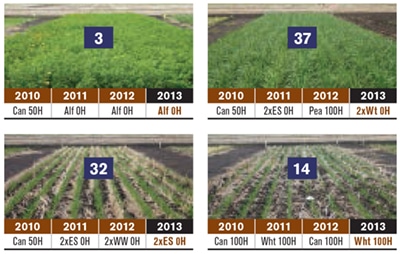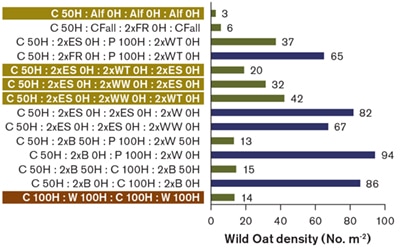Key Result
Crop rotation offers an alternative practice for wild oat control, according to an extensive study at sites in Western Canada, Ontario and Quebec.
Project Summary
Rotations that include fall-seeded crops, silage crops and perennials seem to provide effective wild oat control without the need for herbicides. These principles can be used in an integrated weed management program.
Neil Harker with Agriculture and Agri-Food Canada (AAFC) leads a five-year study at eight sites across Canada: Lacombe, AB, Lethbridge, AB, Edmonton, AB, Scott, SK, Saskatoon, SK, Winnipeg, MB, New Liskeard, ON and Normandin, QC. Experiments and data collection will continue through the 2014 growing season.
The objective is to determine if diverse rotation treatments combined with other cultural practices can reduce wild oat populations. The study will also see if diverse crop rotations influence the wild oat seed bank, soil microbes, and crop quality.
Natural wild oat populations were supplemented with seeded wild oats at each site to ensure adequate, uniform wild oat populations. Broadleaf weeds were treated with full herbicide rates.
Many of the crops were seeded at two times the normal seeding rate.
This no-till study shows that a rotation that includes fall-seeded crops such as winter wheat, perennial crops such as alfalfa, and annual crops with alternative harvest dates, such as silage barley, can provide significant wild oat management and reduce the need for herbicide applications. This can reduce the risk of building up a population of herbicide-resistant wild oats, and provide effective control options in fields where herbicide resistant wild oats already exist.
Figure 1. Selected individual plot photos at Lacombe in the Spring of 2013 (May 31).
Can, Alf, ES, WT, WW and Wht = Canola, Alfalfa, Early-Cut Barley Silage, Winter Triticale, Winter Wheat and Wheat, respectively.

Figure 2. Wild oat emergence density at Lacombe in the Spring of 2013 (June 7).
C, Alf, CFall, FR, ES, P, WT, WW, and Wht = Canola, Alfalfa, Chem Fallow, Fall Rye, Early-Cut Barley Silage, Pea, Winter Triticale, Winter Wheat and Wheat, respectively.






